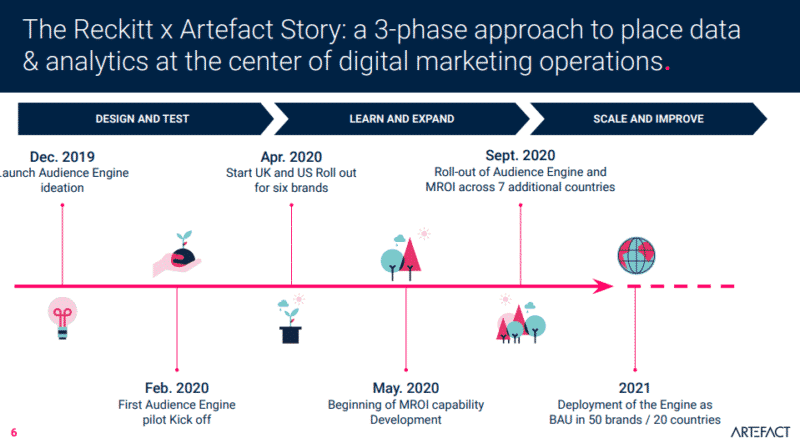L'époque du marketing basé sur des hypothèses est révolue. Pour réussir dans l'environnement actuel, les spécialistes du marketing ont besoin de stratégies data.
Cet article explore la manière dont les marques peuvent combiner les plateformes de gestion d'audience avec des stratégies et des opérations de marketing data afin de proposer des expériences personnalisées et d'améliorer l'efficacité des campagnes.
Comment intensifier les efforts de personnalisation grâce au marketing data?
Tristan Silhol, directeur principal du service de conseil de la société data Artefact , a récemment travaillé avec la société Reckitt, spécialisée dans les produits d'hygiène, de santé et de nutrition, afin de revitaliser ses campagnes de marketing. L'objectif était de faire passer Reckitt d'une approche marketing de masse à un ciblage plus personnalisé des clients.
"Les équipes de marketing stratégique typiques se concentrent sur le marketing basé sur des hypothèses", a-t-il déclaré lors de sa présentation à notre conférence MarTech. "Il s'agit essentiellement d'élaborer des campagnes médiatiques et de personnalisation basées sur des facteurs externes tels que les enquêtes auprès des consommateurs, la connaissance de la marque, les données démographiques data, les données démographiques nationales data, les données statistiques data, et la consommation data."
Il a ajouté : "C'est très bien pour organiser de vastes campagnes, mais cela peut ne pas suffire lorsque les clients actuels attendent beaucoup de personnalisation et un certain niveau de relation".

Passer d'un marketing basé sur des hypothèses à un marketing data n'est pas une tâche simple. Il faut beaucoup de coordination et de ressources pour se concentrer moins sur les facteurs externes et plus sur les data individuelles data clients. Cependant, avec les bonnes stratégies en place, les spécialistes du marketing auront beaucoup plus de facilité à ajuster leurs campagnes.
Adopter des stratégies de marketing data
Si le "marketingdata" semble être une tactique banale, il s'agit en fait d'une manière relativement nouvelle de structurer les campagnes. Le marketing traditionnel s'appuyait sur des stratégies fondées sur des hypothèses pour déterminer ce que voulaient les clients. Aujourd'hui, les nouvelles technologies de marketing permettent aux marques de prendre des décisions basées sur des data clients en temps réel.
"De plus en plus de marques innovent avec des pratiques de marketing data, en essayant de placer les data au centre du processus de marketing. Cela signifie qu'elles consolident trois types de data, dont lesdata first-party - data transactionnelles, CRM et autres actifs numériques que vous possédez en tant qu'entreprise. Elles sont fusionnées avec des data seconde partie provenant de détaillants tels que Walmart ou Amazon. Les technologies programmatiques étendent également leur portée avec des data tierces et des data open-source".
"Ce marketing data représente une très grande partie des opportunités inexploitées pour les marques, et il nécessite beaucoup de capacités et d'innovation", a-t-il ajouté.
Selon Silhol, les entreprises de produits de grande consommation ont souvent du mal à traduire la segmentation traditionnelle basée sur la connaissance des consommateurs et du marché en audiences adressables en raison de l'absence d'une approche data: "Souvent, ces entreprises finissent par cibler arbitrairement des segments en ligne et par avoir un décalage entre ce qui est disponible en termes d'audiences adressables et leur segmentation marketing."

Pour relever ces défis, Silhol recommande aux spécialistes du marketing de se pencher sur la configuration de leurs opérations de marketing pour voir si elle est optimisée pour l'analyse et l'approvisionnement sur data .
Centre Marketing Digital opérations sur data et analyses
Dans la même présentation, Guilherme Amaral de Reckitt a expliqué comment il a travaillé avec l'équipe de Artefactpour introduire le site data et des informations sur les clients dans l'automatisation de leurs campagnes.
"Nous avons lancé tout un programme de transformation numérique axé sur la transformation de la manière dont nous menons les campagnes médiatiques numériques", a-t-il déclaré. "Ce n'était que la première étape pour mettre en place des campagnes réussies.
Et d'ajouter : "Nous avons également parlé du bon site data, des bons processus, de la bonne technologie et de l'internalisation de certaines de ces capacités".

L'internalisation a été un élément majeur de la transformation des opérations marketing de Reckitt. L'internalisation des opérations a permis de réduire les dépenses liées aux outils de mesure externes, de centraliser les clients data, de créer des audiences avec sa propre IA et de mesurer data de manière indépendante.
Mettre en place un système de gestion de l'audience
Artefact a aidé Reckitt à mettre en place une technologie de gestion d'audience pour aider à développer ces efforts de marketing data.

Avec les réglementations à venir sur data consommateurs, les spécialistes du marketing ont besoin de moyens pour tirer parti de toutes leurs data clients, en particulier s'ils espèrent offrir des expériences personnalisées. Les plateformes de gestion de l'audience (telles que le moteur d'audience), combinées à des stratégies et opérations de marketing data, ont le potentiel de résoudre ce problème en améliorant l'efficacité et la personnalisation des campagnes.
Elle ajoute : "Nous continuons à travailler et à évoluer parce que le moteur d'audience a eu un impact considérable sur notre activité."
Merci beaucoup pour votre lecture ! N'hésitez pas à nous contacter si vous souhaitez contribuer au développement du paquet ou si vous avez des idées d'amélioration. En attendant, vous pouvez visiter le blogArtefact pour plus d'informations sur nos projets data .

 BLOG
BLOG







